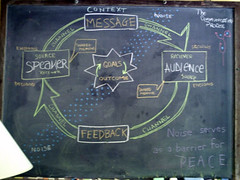 Communication is at the heart of a healthy community. Feeling safe to express both appreciation and concern to your cos* is important for a vibrant and fluid, yet stable, group relationship.
Communication is at the heart of a healthy community. Feeling safe to express both appreciation and concern to your cos* is important for a vibrant and fluid, yet stable, group relationship.Without a clear chain of command or a traditionally structured student/teacher model here at the ETC, it can be a little confusing for the new apprentices to know who to talk to about their reflections on the program. Last week Cliff sat down with the apprentices, KMO and me to talk about how the evolution of the apprenticeship program reflects a natural system, such as a forest or prairie.
Instead of the main stream approach to teaching, where the instructor draws up a detailed syllabus with specific plans for each week, the Permaculture Immersion Apprenticeship Program mimics the regrowth pattern that happens in the space left by a downed tree in the forest. While there are planned projects for the season, and an overarching view of what needs to be accomplished by the end of an apprenticeship, the first week or so of the program may seem a bit chaotic. Just like the myriad of small plants and saplings that spring up in the new sunshine left by a hole in the forest canopy, the first few days of the program is about trying new ideas and getting a feel for what works and what doesn't.
Each group of apprentices comes in with its own expectations and desires to learn about one subject or another. We love that, and work with them to establish a schedule that accommodates both their passions and the ETC's need to accomplish the planned projects. And just like the seemingly patternless growth of random plants in the space around the downed tree, the chaos eventually falls into a pattern. Healthy, strong, fast growing saplings eventually shade out the weaker, smaller ones. As coordinators communicate the overreaching vision for the program and start offering suggestions as to what could happen first, the apprentices are encouraged to give feedback. The feedback is considered, and new suggestions may be made.
Once a schedule is agreed upon, then it's up to both the apprentices and the coordinators to keep communicating during the apprenticeship to make sure that everyone is included to their desired level and that the project gets completed within the agreed upon time frame. Some of our feedback tools include a "check-in" where coordinators and apprentices get a chance to talk about what's going well and what's challenging, an "intention blackboard" where apprentices and coordinators can write in their ideas about projects for the near future, and a co-counseling technique called "think and listen" where apprentices have a chance to process what they learned during the previous week.
These tools, along with informal chit-chat around meals or work, give space for a healthy community to flourish. Hopefully, the community that develops will prove to be as beautiful, rich, resilient and diverse as the forest that surrounds us here at the ETC.
*Co, which stands for community member, is a non gender specific pronoun commonly used in intentional communities which support gender identification freedom of choice.
No comments:
Post a Comment